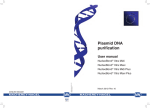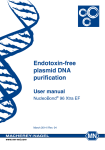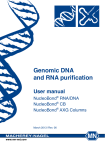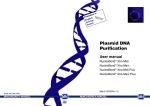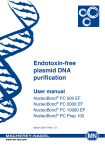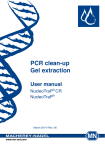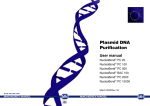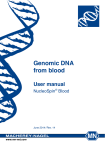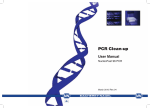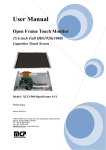Download Plasmid DNA concentration and desalting - MACHEREY
Transcript
Plasmid DNA concentration and desalting User manual NucleoBond® Finalizer NucleoBond® Finalizer Large October 2015 / Rev. 07 Plasmid DNA concentration and desalting Protocol-at-a-glance (Rev. 07) 1 Precipitate DNA 2 Load precipitate 3 Wash precipitate 4 Dry filter membrane NucleoBond® Finalizer NucleoBond® Finalizer Large 3.5 mL isopropanol for 5 mL eluate 10.5 mL isopropanol for 15 mL eluate Mix thoroughly Mix thoroughly (Watch salt concentration) (Watch salt concentration) RT, 2 min RT, 2 min Press slowly! 2 mL 70 % ethanol 5 mL 70 % ethanol ≥ 3 x air ≥ 6 x air Press fast! 5 Elute DNA Two-fold elution: Two-fold elution: 1st elution 1st elution 200–800 μL Tris or TE buffer 2nd elution oad first eluate completely 400–1000 μL Tris or TE buffer Press very slowly! 2nd elution Load first eluate completely Recover as much eluate as possible by quickly pressing air through the filter. MACHEREY-NAGEL GmbH & Co. KG · Neumann-Neander-Str. 6–8 · 52355 Düren · Germany Tel.: +49 24 21 969-270 · Fax: +49 24 21 969-199 · [email protected] · www.mn-net.com Plasmid DNA concentration and desalting Table of contents 1Components 4 1.1 Kit contents 4 1.3 About this user manual 4 1.2 Reagents to be supplied by the user 2 Product description 4 5 2.1 The basic principle 5 2.3 DNA precipitation 6 2.2 Kit specifications 2.4 Elution procedure 5 7 3 Storage conditions 10 4 Safety instructions 10 5 Protocol for DNA concentration and desalination 11 6Appendix 6.1 Determination of DNA yield and quality 6.2Troubleshooting 6.3 Ordering information 6.4 Product use restriction / warranty MACHEREY-NAGEL – 10/2015, Rev. 07 13 13 13 16 17 3 Plasmid DNA concentration and desalting 1 Components 1.1 Kit contents NucleoBond® Finalizer NucleoBond® Finalizer Plus 740519.20 740520.20 NucleoBond® Finalizer 20 20 30 mL Syringes 2 20 1 mL Syringes 2 20 User manual 1 1 NucleoBond® Finalizer Large NucleoBond® Finalizer Large Plus 740418.20 740419.20 NucleoBond® Finalizer Large 20 20 30 mL Syringes 2 20 1 mL Syringes 2 20 User manual 1 1 REF REF 1.2 Reagents to be supplied by the user • Isopropanol (room-temperatured) • 70 % ethanol (room-temperatured) • Buffer for reconstitution of DNA (e.g., Tris or TE buffer; see section 2.4) 1.3 About this user manual It is strongly recommended that first-time users of the NucleoBond® Finalizer (Large) read the detailed protocol sections of this user manual. Experienced users, however, may refer to the Protocol-at-a-glance instead. The Protocol-at-a-glance is designed to be used only as a supplemental tool for quick referencing while performing the purification procedure. All technical literature is available on the internet at www.mn-net.com. 4 MACHEREY-NAGEL – 10/2015, Rev. 07 Plasmid DNA concentration and desalting 2 Product description 2.1 The basic principle NucleoBond® Finalizers are designed for quick concentration and desalination of plasmid and cosmid DNA eluates that are obtained by anion-exchange chromatographic DNA purification with NucleoBond® AX and NucleoBond® Xtra Columns. The sample is precipitated with isopropanol and loaded onto a NucleoBond® Finalizer membrane by means of a syringe. After an ethanolic washing step and drying of the membrane the pure DNA can be eluted with low salt buffer for further use. The NucleoBond® Finalizer technology replaces the tedious and time-consuming centrifugation step which hitherto follows every isopropanol precipitation of diluted DNA samples. Furthermore problems like lost DNA pellets or incomplete solubilization of hardly visible precipitates can easily be circumvented. The pure concentrated and salt free DNA can be used directly for all common downstream applications like transfection, in vitro transcription, automated or manual sequencing, cloning, hybridization, and PCR. 2.2 Kit specifications • The NucleoBond® Finalizer kits contain the NucleoBond® Finalizers and a set of 30 mL and 1 mL syringes for sample loading and DNA elution. • The protocol is suitable for purifying most plasmids and cosmids ranging from 2–50 kbp. • NucleoBond® Finalizers are polypropylene filters containing a special silica membrane. The NucleoBond® Finalizer with a binding capacity of 500 μg is suitable for use with NucleoBond® PC 100, PC 500, and NucleoBond® Xtra Midi kits. The NucleoBond® Finalizer Large can hold up to 2000 μg and is suitable for use with NucleoBond® Xtra Maxi and NucleoBond® PC 2000 kits. Both NucleoBond® Finalizers are also suitable for all other plasmid DNA purification or concentration procedures resulting in an isopropanol DNA precipitate. • The NucleoBond® Finalizers are free of endotoxins and can therefore be used with NucleoBond® PC EF kits and NucleoBond® Xtra EF kits as well. • All NucleoBond® Finalizers are resistant to organic solvents such as alcohol, chloroform, and phenol and are free of DNase and RNase. • Using the NucleoBond® Finalizer kits reduces the necessary hands-on time to obtain concentrated DNA from over an hour to about 5 minutes. • Due to the small filter size an effective washing step reduces chloride concentration in the final eluate to < 0.3 μg/μL. • The supplied syringes may be reused when washed with sufficient water. MACHEREY-NAGEL – 10/2015, Rev. 07 5 Plasmid DNA concentration and desalting Table 1: Kit specifications at a glance Parameter Loadable volume Unlimited Binding capacity Elution volume 500 μg DNA 2000 μg DNA > 200 μL > 400 μL Typical recovery (elution volume dependent) 40–90 % Typical concentration (elution volume dependent) 0.1–3 μg/μL Plasmid size 2–50 kbp Residual chloride concentration < 0.3 μg/μL Dead volume ~ 30 μL Preparation time To be combined with NucleoBond® Finalizer Large NucleoBond® Finalizer ~ 60 μL 5 min NucleoBond® Xtra Midi NucleoBond® Xtra Midi EF NucleoBond® PC 100 NucleoBond® PC 500 NucleoBond® PC 500 EF NucleoBond® Xtra Maxi NucleoBond® Xtra Maxi EF NucleoBond® PC 2000 NucleoBond® PC 2000 EF 2.3 DNA precipitation In general diluted DNA can be precipitated by adding 0.7 volumes of isopropanol to solutions containing at least 0.3 M sodium acetate, 0.2 M sodium chloride, or 0.2 M potassium chloride. Make sure your samples contain enough salt before using the NucleoBond® Finalizer kits. NucleoBond® PC 100, PC 500, PC 2000, Xtra Midi, and Xtra Maxi eluates as well as similar anion-exchange chromatography eluates already contain a sufficient amount of salt to allow a quantitative DNA precipitation. Here, only addition of 0.7 volumes of room temperature (20–25 °C) isopropanol (not provided in the kit) is necessary. Do not let the plasmid DNA solution drop into a vial with isopropanol, because this might lead to spontaneous co-precipitation of salt. 6 MACHEREY-NAGEL – 10/2015, Rev. 07 Plasmid DNA concentration and desalting 2.4 Elution procedure Elution from the NucleoBond® Finalizers is carried out with slightly alkaline buffers like TE buffer (10 mM Tris/HCl, pH 7.5, 1 mM EDTA) or Tris buffer (5 mM Tris / HCl, pH 8.5). DNA precipitation is performed at room temperature in contrast to a standard incubation on ice or -20 °C in order to avoid co-precipitation of salt. For maximum yield it is recommended to perform the elution step twice. The first elution step is done using fresh buffer whereas in the second elution step the eluate from the first elution is reapplied on the NucleoBond® Finalizer to allow complete solubilization of the plasmid. DNA recovery highly depends on the used elution buffer volume. Large volumes result in a high recovery of up to 90 % but in a lower DNA concentration. Small elution volumes on the other hand increase the concentration but at the cost of DNA yield. If a small volume is chosen, make sure to recover as much eluate as possible from the syringe and NucleoBond® Finalizer by pressing air through the NucleoBond® Finalizer several times after elution and collecting every single droplet to minimize the dead volume. 100 2.0 90 1.8 80 1.6 70 1.4 60 1.2 50 1.0 40 0.8 30 0.6 20 0.4 10 0.2 0 0 200 400 600 800 1000 Concentration [μg/μL] Recovery [%] Figure 1 and Figure 2 on 7 and 8 illustrate exemplarily how DNA recovery and final DNA concentration depend on the buffer volume which is used for elution of DNA from the NucleoBond® Finalizer and NucleoBond® Finalizer Large, respectively. Recovery Concentration Concentration [µg/µl] 0.0 Elution volume [μL] Figure 1 Final DNA recovery and concentration after NucleoBond® Finalizer application A NucleoBond® Xtra Midi eluate containing 250 μg plasmid DNA (8 kbp) was loaded onto a NucleoBond® Finalizer and eluted two-fold with increasing volumes of TE buffer. The NucleoBond® Finalizer is designed to hold a maximum of 500 μg DNA and is therefore ideally suited to be used in combination with NucleoBond® PC 100, PC 500, and NucleoBond® Xtra Midi. Maximum DNA recovery can be achieved by using > 600 μL of elution buffer. For a higher concentration experienced users can lower the elution buffer volume to 400–200 μL. Table 2 gives an overview about recovery and concentration of different amounts of plasmid DNA loaded onto a NucleoBond® Finalizer and eluted two-fold with increasing MACHEREY-NAGEL – 10/2015, Rev. 07 7 Plasmid DNA concentration and desalting volumes of TE buffer. Please refer to this table to select an elution buffer volume that meets your needs best. Table 2: DNA recovery and concentration for the NucleoBond® Finalizer Loaded DNA Elution volume 100 μL 200 μL 400 μL 600 μL 800 μL 1000 μL 500 μg 35 % 2.5 μg/μL 60 % 2.3 μg/μL 70 % 1.2 μg/μL 75 % 0.8 μg/μL 75 % 0.6 μg / μL 75 % 0.5 μg/μL 250 μg 40 % 1.9 μg/μL 65 % 1.1 μg/μL 75 % 0.6 μg/μL 80 % 0.4 μg/μL 80 % 0.3 μg / μL 80 % 0.2 μg/μL 100 μg 45 % 0.7 μg/μL 70 % 0.4 μg/μL 80 % 0.2 μg/μL 85 % 0.1 μg/μL 85 % 0.1 μg / μL 85 % 0.1 μg/μL 50 μg 30 % 0.3 μg/μL 75 % 0.2 μg/μL 85 % 0.1 μg/μL 90 % 0.1 μg/μL 90 % 0.1 μg / μL 90 % < 0.1 μg/μL DNA recovery DNA concentration 90 2.5 Recovery [%] 80 70 2.0 60 1.5 50 40 1.0 30 20 0.5 10 0 0 200 400 600 800 1000 Concentration [μg/μL] 3.0 100 Recovery Concentration Concentration [µg/µl] 0.0 Elution volume [μL] Figure 2 Final DNA recovery and concentration after NucleoBond® Finalizer Large application A NucleoBond® Xtra Maxi eluate containing 1000 μg plasmid DNA (8 kbp) was loaded onto a NucleoBond® Finalizer Large and eluted two-fold with increasing volumes of TE buffer. NucleoBond® Xtra Maxi and NucleoBond® PC 2000 eluates are easily concentrated with a NucleoBond® Finalizer Large which is able to bind up to 2000 μg plasmid DNA. Maximum DNA recovery can be achieved by using > 800 μL of elution buffer. For a higher concentration experienced users can lower the elution buffer volume to 600–400 μL. Table 3 gives an overview about recovery and concentration of different amounts of plasmid DNA loaded onto a NucleoBond® Finalizer Large and eluted two-fold with increasing volumes of TE buffer. Please refer to this tables to select an elution buffer volume that meets your needs best. 8 MACHEREY-NAGEL – 10/2015, Rev. 07 Plasmid DNA concentration and desalting Table 3: DNA recovery and concentration for the NucleoBond® Finalizer Large Loaded DNA Elution volume 100 μL 200 μL 400 μL 600 μL 800 μL 1000 μL 1500 μg 5 % 1.9 μg/μL 30 % 3.2 μg/μL 65 % 2.9 μg/μL 80 % 2.2 μg/μL 85 % 1.7 μg / μL 90 % 1.4 μg/μL 1000 μg 5 % 1.3 μg/μL 35 % 2.5 μg/μL 70 % 2.1 μg/μL 85 % 1.6 μg/μL 90 % 1.2 μg / μL 90 % 1.0 μg/μL 500 μg 10 % 1.3 μg/μL 40 % 1.4 μg/μL 70 % 1.0 μg/μL 85 % 0.8 μg/μL 85 % 0.6 μg / μL 90 % 0.5 μg/μL 100 μg 15 % 0.4 μg/μL 45 % 0.3 μg/μL 70 % 0.2 μg/μL 80 % 0.1 μg/μL 85 % 0.1 μg / μL 90 % 1.0 μg/μL DNA recovery DNA concentration MACHEREY-NAGEL – 10/2015, Rev. 07 9 Plasmid DNA concentration and desalting 3 Storage conditions All kit components can be stored at room temperature (18–25 °C). 4 Safety instructions The components of the NucleoBond® Finalizer and NucleoBond® Finalizer Large kits do not contain hazardous contents. 10 MACHEREY-NAGEL – 10/2015, Rev. 07 NucleoBond® Finalizer / Finalizer Large 5 Protocol for DNA concentration and desalination NucleoBond® Finalizer 1 NucleoBond® Finalizer Large Precipitate DNA Note: Check DNA concentration photometrically before precipitation. This helps to choose the best buffer volume in step 5 and allows calculation of the recovery after concentration. Using eluates from anion-exchange chromatography add 0.7 volumes of roomtemperature isopropanol (not supplied with the kit). Vortex well and let the mixture sit for 2 minutes. (E.g., for 5 mL NucleoBond® PC 100 or Xtra Midi eluate add 3.5 mL isopropanol, for 15 mL NucleoBond® PC 500 or Xtra Maxi eluate add 10.5 mL isopropanol.) If your sample does not contain high salt concentrations (e.g., 0.2 M sodium chloride, 0.3 M sodium acetate, or 0.2 M potassium chloride), add about 1/10 volume of 3 M sodium acetate (pH 4.2) before adding isopropanol. 3.5 mL for 5 mL eluate 2 10.5 mL for 15 mL eluate Load precipitate Remove the plunger from a 30 mL Syringe and attach a NucleoBond® Finalizer to the outlet. Fill the precipitation mixture into the syringe, insert the plunger, hold the syringe in a vertical position, and press the mixture slowly through the NucleoBond® Finalizer using minimal force. Discard the flow-through. 3 Wash precipitate Remove the NucleoBond® Finalizer from the syringe, pull out the plunger and reattach the NucleoBond® Finalizer to the syringe outlet. Fill 70 % ethanol (not supplied with the kit) into the syringe, insert the plunger, hold the syringe in vertical position, and press the ethanol slowly through the NucleoBond® Finalizer. Discard the ethanol. 2 mL 5 mL MACHEREY-NAGEL – 10/2015, Rev. 07 11 NucleoBond® Finalizer / Finalizer Large NucleoBond® Finalizer 4 NucleoBond® Finalizer Large Dry filter membrane Remove the NucleoBond® Finalizer from the syringe, pull out the plunger and reattach the NucleoBond® Finalizer. Press air through the NucleoBond® Finalizer while touching a tissue as strongly as possible with the tip of the NucleoBond® Finalizer to soak up ethanol. Repeat this step at least as often as indicated below until no more ethanol leaks from the NucleoBond® Finalizer. Note: A new dry syringe can be used to speed up the procedure (not provided). ≥ 3 times until dry ≥ 6 times until dry Optional: You can incubate the NucleoBond® Finalizer for 10 minutes at 80 °C to minimize ethanol carry-over. However, the final recovery may be reduced by over-drying the DNA. 5 Elute DNA Remove the NucleoBond® Finalizer from the syringe, pull out the plunger of a 1 mL Syringe and attach the NucleoBond® Finalizer to the syringe outlet. Note: Refer to section 2.4, Table 2 (Midi) or Table 3 (Maxi) to choose the appropriate volume of elution buffer. Pipette an appropriate volume of Tris buffer or TE buffer (see section 2.4) into the syringe. Do not use pure water unless pH is definitely higher than 7. Place the NucleoBond® Finalizer outlet in a vertical position over a fresh collection tube (not provided) and elute plasmid DNA very slowly, drop by drop, by inserting the plunger. 200–800 μL 400–1000 μL ® Remove the NucleoBond Finalizer from the syringe, pull out the plunger and reattach the NucleoBond® Finalizer to the syringe outlet. ! Transfer the first eluate back into the syringe and elute into the same collection tube a second time. Load first eluate completely Load first eluate completely ® Remove the NucleoBond Finalizer from the syringe, pull out the plunger to aspirate air, reattach the NucleoBond® Finalizer, and press the air out again to force out as much eluate as possible. Determine plasmid yield by UV spectroscopy and confirm plasmid integrity by agarose gel electrophoresis (see section 6.1). 12 MACHEREY-NAGEL – 10/2015, Rev. 07 Plasmid DNA concentration and desalting 6 Appendix 6.1 Determination of DNA yield and quality The yield of a plasmid preparation should be estimated prior to and after the isopropanol precipitation in order to calculate the recovery after precipitation and to find the best elution volume for the NucleoBond® Finalizers. Simply use the NucleoBond® PC or NucleoBond® Xtra elution buffer (for estimation prior to precipitation) or the respective low-salt buffer (for estimation after the precipitation) as a blank in your photometric measurement. The nucleic acid concentration of the sample can be calculated from its UV absorbance at 260 nm where an absorbance of 1 (1 cm path length) is equivalent to 50 μg DNA/mL. Note that the absolute measured absorbance should lie between 0.1 and 0.7 to be in the linear part of Lambert-Beer´s law. Dilute your sample in the respective buffer if necessary. The plasmid purity can be checked by UV spectroscopy as well. A ratio of A260/A280 between 1.80–1.90 and A260/A230 around 2.0 indicates pure plasmid DNA. An A260/A280 ratio above 2.0 is a sign for too much RNA in your preparation, an A260/A280 ratio below 1.8 indicates protein contamination. Plasmid quality can be checked by running the precipitated samples on a 1 % agarose gel. This will give information on conformation and structural integrity of isolated plasmid DNA i.e. it shows whether the sample is predominantly in the favorable super-coiled (ccc, usually the fastest band), open circle (oc) or even linear form. 6.2 Troubleshooting If you experience problems with reduced purity or quality, we recommend to check your DNA before concentration with the NucleoBond® Finalizers. Usually the purification procedure itself and not the NucleoBond® Finalizer is causing these problems. However, if your main difficulty is low yield although you had plenty of DNA before applying the NucleoBond® Finalizer then please check the following table for detailed explanations. MACHEREY-NAGEL – 10/2015, Rev. 07 13 Plasmid DNA concentration and desalting Problem Possible cause and suggestions Incomplete precipitation • Usually all sizes of plasmid or cosmid DNA are precipitated with high efficiency of about 90 % at room temperature in the presence of at least 0.2 M sodium chloride or 0.3 M sodium acetate and 40 % isopropanol. Therefore make sure your sample contains enough salt and alcohol. Almost 100 % recovery can be achieved by incubation at 0 °C or -20 °C for 20 min. But this may lead to co-precipitation of salt and clogging of the NucleoBond® Finalizer membrane and is therefore not recommended. Plasmid size • Precipitation efficiency is almost independent of plasmid size, but elution from the NucleoBond® Finalizers becomes more and more difficult with increasing construct size. If you face low yields with large cosmids you may try heating the NucleoBond® Finalizer, the syringes, and elution buffer to 70 °C. Dead volume too high No or low plasmid DNA yield • If high concentration of plasmid DNA is the main aim, elution should be performed in small volumes. Naturally a portion of the eluate will be lost in the syringe and on the NucleoBond® Finalizer. To minimize these losses in the second elution step, try to transfer even the last droplet from the syringe to the NucleoBond® Finalizer, for example by tapping the NucleoBond® Finalizer and syringe onto the bench top. Then fill the syringe with air and press forcefully the last droplets out of the NucleoBond® Finalizer. Repeat this step several times. You might have to practice this procedure several times to achieve optimal results. An acceptable dead volume is smaller than 30 μL with NucleoBond® Finalizer and 60 μL with NucleoBond® Finalizer Large. Elution volume too small • 14 Since there are certain dead volumes of about 30 μL (NucleoBond® Finalizer) and 60 μL (NucleoBond® Finalizer Large), reasonable elution volumes start with 200 μL (NucleoBond® Finalizer) and 400 μL (NucleoBond® Finalizer Large), respectively. Furthermore smaller volumes are insufficient to wet the entire membrane and will drastically decrease your yield. Refer to section 2.4, Table 2 (NucleoBond® Finalizer) and Table 3 (NucleoBond® Finalizer Large) to estimate the recovery that can be expected depending on elution buffer volume. MACHEREY-NAGEL – 10/2015, Rev. 07 Plasmid DNA concentration and desalting Problem Possible cause and suggestions Elution too fast • No or low plasmid DNA yield (continued) Plasmid DNA needs time to dissolve. Elute really very slowly, drop by drop. Repeat the elution procedure using the first eluate. Forgot to elute a second time • Repeating the elution procedure with the first eluate is crucial for optimal yields. However, eluting a third time shows no more improvement. Low overall yield • Refer to detailed troubleshooting “No or low plasmid DNA yield” and lower your elution buffer volume. Refer to section 2.4, Table 2 and Table 3 to estimate the DNA concentrations that can be expected. Fresh elution buffer used for second elution step • Low DNA concentration The second elution step is crucial for optimal yield but to achieve a high DNA concentration the eluate of the first elution step has to be used for the second elution. Not enough DNA loaded • Since there is a technical limitation to at least 200 μL (NucleoBond® Finalizer) and 400 μL (NucleoBond® Finalizer Large) of elution buffer due to membrane wetting and dead volume, a minimal amount of DNA has to be loaded to achieve a desired concentration. If possible try to pool several DNA precipitation batches since percentage of recovery and concentration significantly increase with higher amounts of loaded DNA (see section 2.4, Table 2 and Table 3). MACHEREY-NAGEL – 10/2015, Rev. 07 15 Plasmid DNA concentration and desalting 6.3 Ordering information Product REF Pack of NucleoBond® Finalizer (for use with NucleoBond® Xtra Midi, Midi EF, NucleoBond® PC 100, PC 500, PC 500 EF) 740519.20 20 filters 2 syringe sets NucleoBond® Finalizer Plus (for use with NucleoBond® Xtra Midi, Midi EF, NucleoBond® PC 100, PC 500, PC 500 EF) 740520.20 20 filters 20 syringe sets NucleoBond® Finalizer Large (for use with NucleoBond® Xtra Maxi, Maxi EF, NucleoBond® PC 2000, PC 2000 EF) 740418.20 20 large filters 2 syringe sets NucleoBond® Finalizer Large Plus (for use with NucleoBond® Xtra Maxi, Maxi EF, NucleoBond® PC 2000, PC 2000 EF) 740419.20 20 large filters 20 syringe sets NucleoBond® Xtra Midi 740410.10 / .50 / .100 10 / 50 / 100 preps NucleoBond Xtra Midi Plus (including NucleoBond® Finalizer) 740412.10 / .50 10 / 50 preps NucleoBond® Xtra Maxi 740414.10 / .50 / .100 10 / 50 / 100 preps NucleoBond® Xtra Maxi Plus (including NucleoBond® Finalizer Large) 740416.10 / .50 10 / 50 preps NucleoBond® PC 100 740573 / .100 20 / 100 preps NucleoBond® PC 500 740574 / .25 / .50 / .100 10 / 25 / 50 / 100 preps NucleoBond® PC 2000 740576 ® Visit www.mn-net.com for more detailed product information. 16 MACHEREY-NAGEL – 10/2015, Rev. 07 5 preps Plasmid DNA concentration and desalting 6.4 Product use restriction / warranty NucleoBond® Finalizer kit components are intended, developed, designed, and sold FOR RESEARCH PURPOSES ONLY, except, however, any other function of the product being expressly described in original MACHEREY-NAGEL product leaflets. MACHEREY-NAGEL products are intended for GENERAL LABORATORY USE ONLY! MACHEREY-NAGEL products are suited for QUALIFIED PERSONNEL ONLY! MACHEREY-NAGEL products shall in any event only be used wearing adequate PROTECTIVE CLOTHING. For detailed information please refer to the respective Material Safety Data Sheet of the product! MACHEREY-NAGEL products shall exclusively be used in an ADEQUATE TEST ENVIRONMENT. MACHEREY-NAGEL does not assume any responsibility for damages due to improper application of our products in other fields of application. Application on the human body is STRICTLY FORBIDDEN. The respective user is liable for any and all damages resulting from such application. DNA/RNA/PROTEIN purification products of MACHEREY-NAGEL are suitable for IN VITRO-USES ONLY! ONLY MACHEREY-NAGEL products specially labeled as IVD are also suitable for IN VITRO-diagnostic use. Please pay attention to the package of the product. IN VITROdiagnostic products are expressly marked as IVD on the packaging. IF THERE IS NO IVD SIGN, THE PRODUCT SHALL NOT BE SUITABLE FOR IN VITRO-DIAGNOSTIC USE! ALL OTHER PRODUCTS NOT LABELED AS IVD ARE NOT SUITED FOR ANY CLINICAL USE (INCLUDING, BUT NOT LIMITED TO DIAGNOSTIC, THERAPEUTIC AND/OR PROGNOSTIC USE). No claim or representations is intended for its use to identify any specific organism or for clinical use (included, but not limited to diagnostic, prognostic, therapeutic, or blood banking). It is rather in the responsibility of the user or - in any case of resale of the products - in the responsibility of the reseller to inspect and assure the use of the DNA/RNA/protein purification products of MACHEREY-NAGEL for a well-defined and specific application. MACHEREY-NAGEL shall only be responsible for the product specifications and the performance range of MN products according to the specifications of in-house quality control, product documentation and marketing material. This MACHEREY-NAGEL product is shipped with documentation stating specifications and other technical information. MACHEREY-NAGEL warrants to meet the stated specifications. MACHEREY-NAGEL´s sole obligation and the customer´s sole remedy is limited to replacement of products free of charge in the event products fail to perform as warranted. Supplementary reference is made to the general business terms and conditions of MACHEREY-NAGEL, which are printed on the price list. Please contact us if you wish to get an extra copy. There is no warranty for and MACHEREY-NAGEL is not liable for damages or defects arising in shipping and handling (transport insurance for customers excluded), or out of accident or improper or abnormal use of this product; defects in products or MACHEREY-NAGEL – 10/2015, Rev. 07 17 EN ISO 9001 EN ISO 13485 CERTIFIED MACHEREY-NAGEL GmbH & Co. KG · Neumann-Neander-Str. 6–8 · 52355 Düren · Germany France: Switzerland: Germany USA: MACHEREY-NAGEL EURL MACHEREY-NAGEL Inc. MACHEREY-NAGEL AG and international: Tel.: +33 388 68 22 68 Tel.: +41 62 388 55 00 Tel.: +49 24 21 969-0 Tel.: +1 484 821 0984 E-mail: [email protected] E-mail: [email protected] E-mail: [email protected] E-mail: [email protected] A029822/1050.7 MACHEREY-NAGEL


















